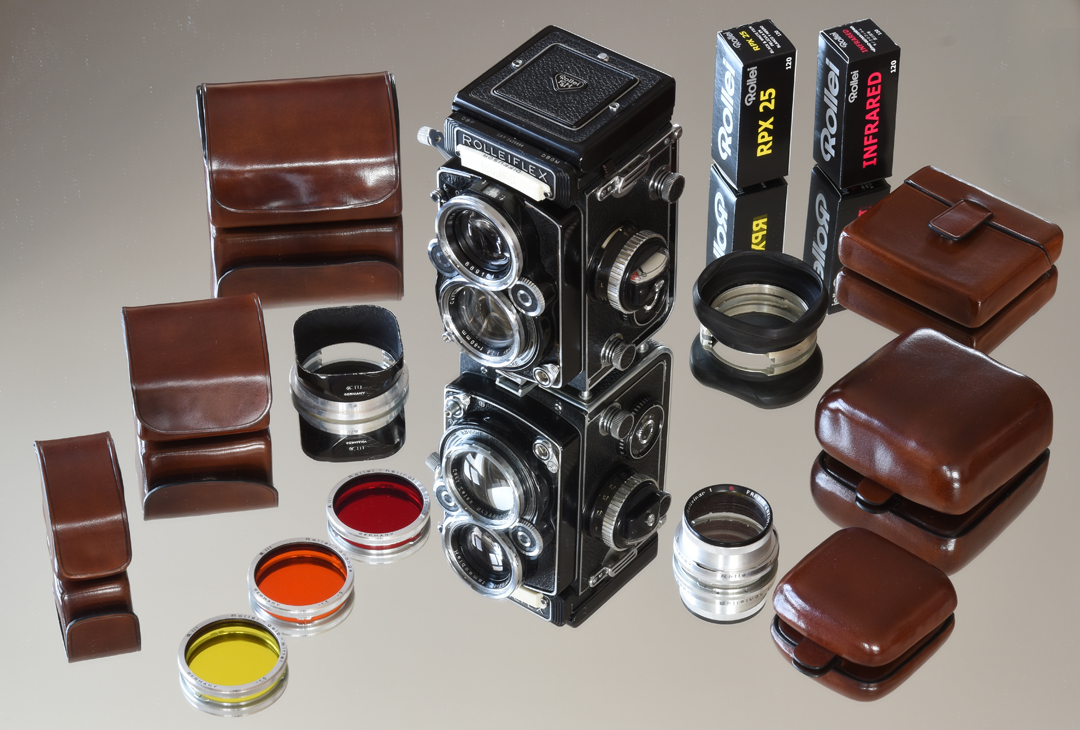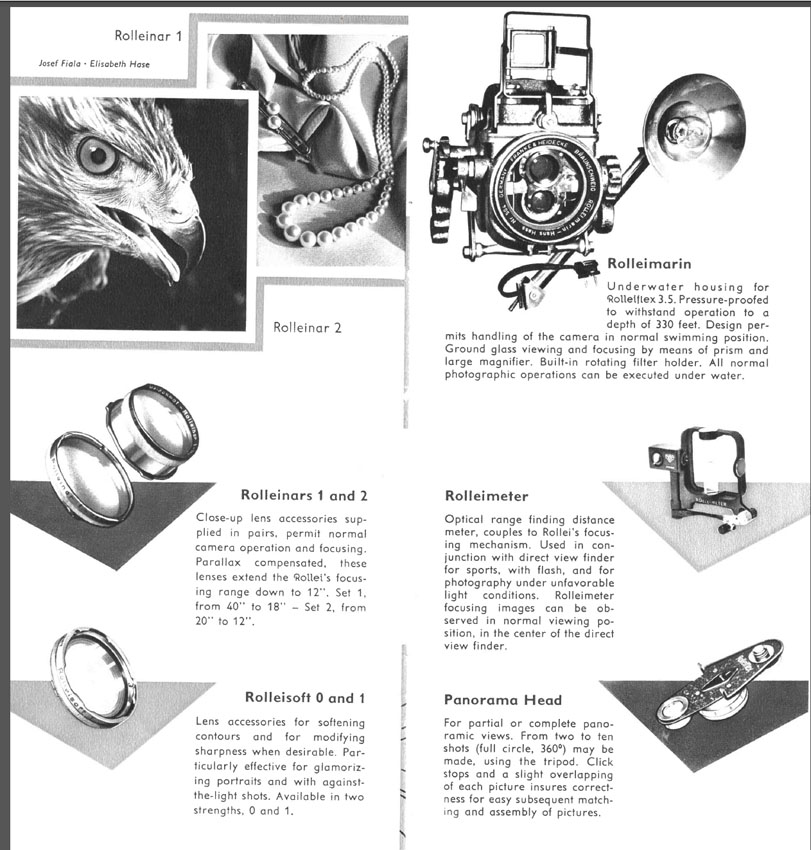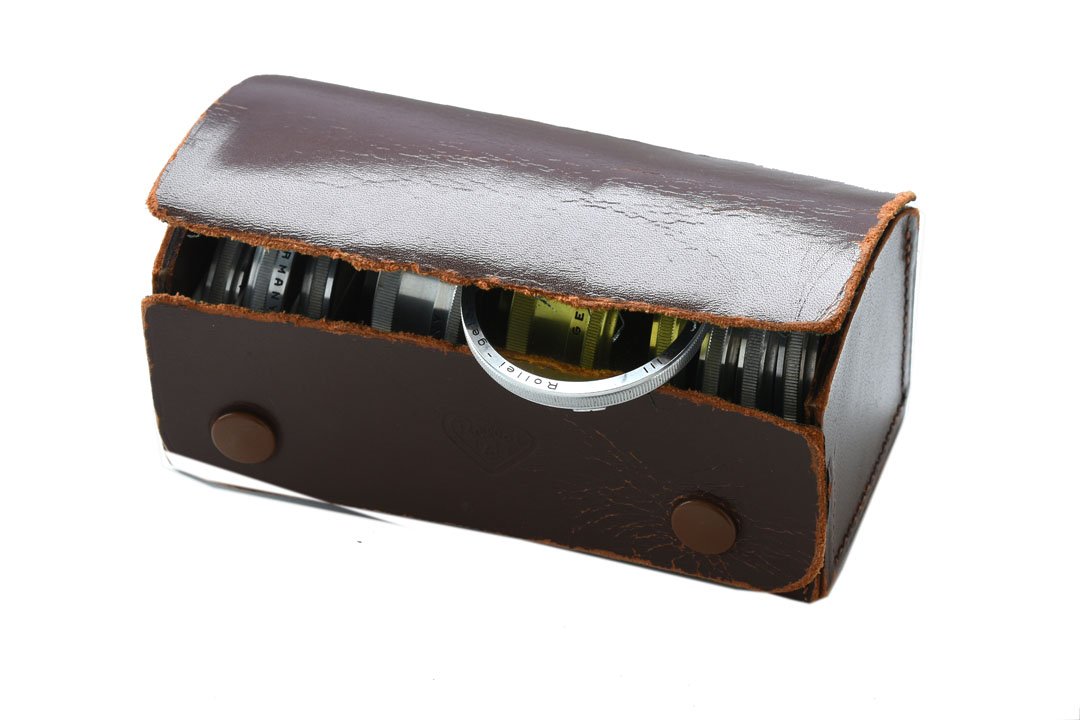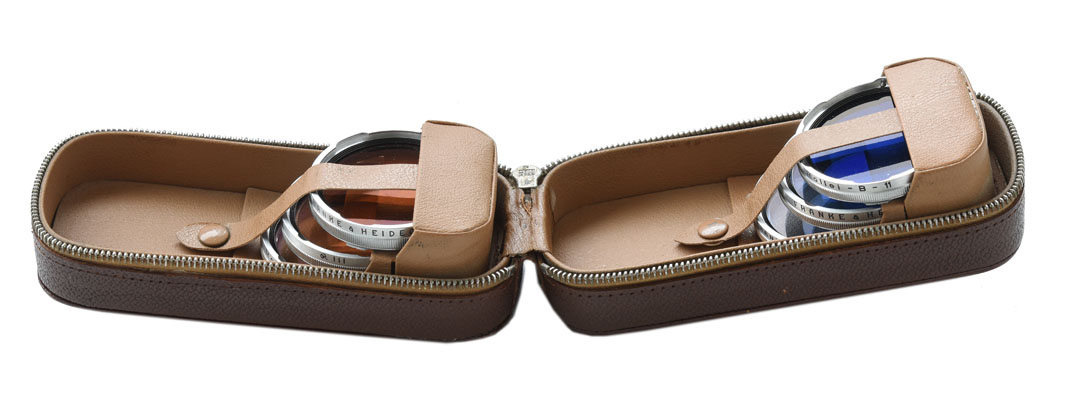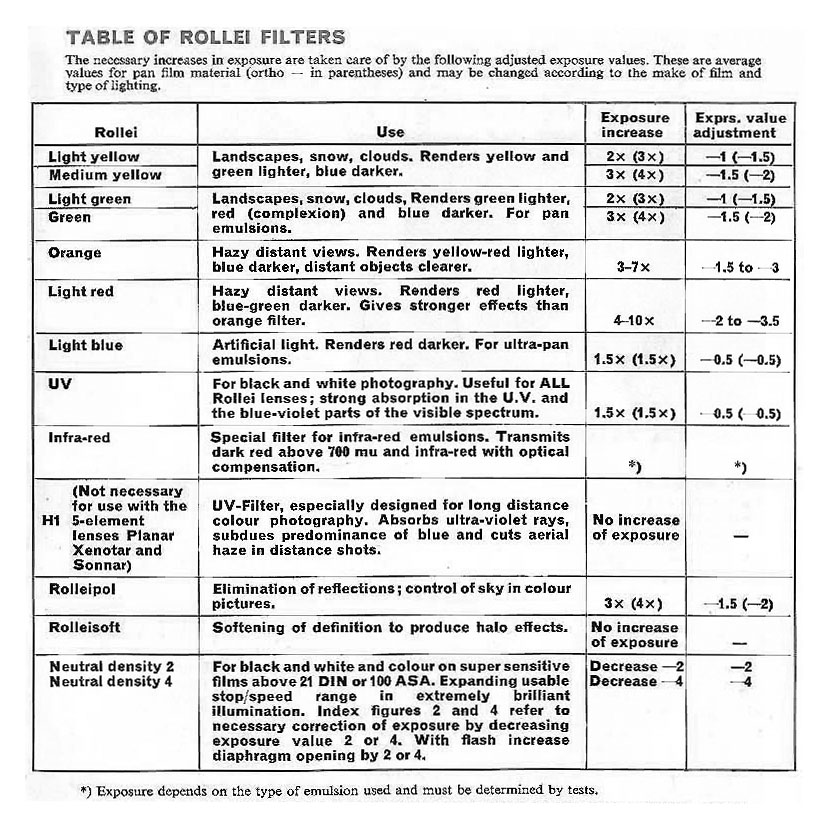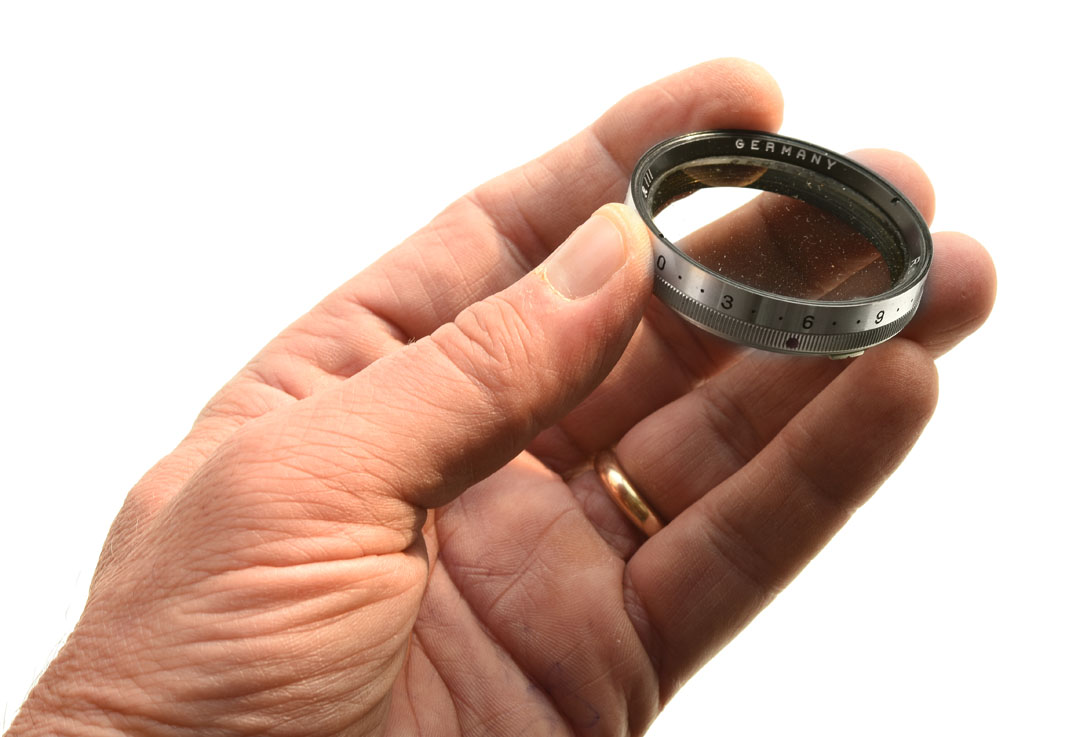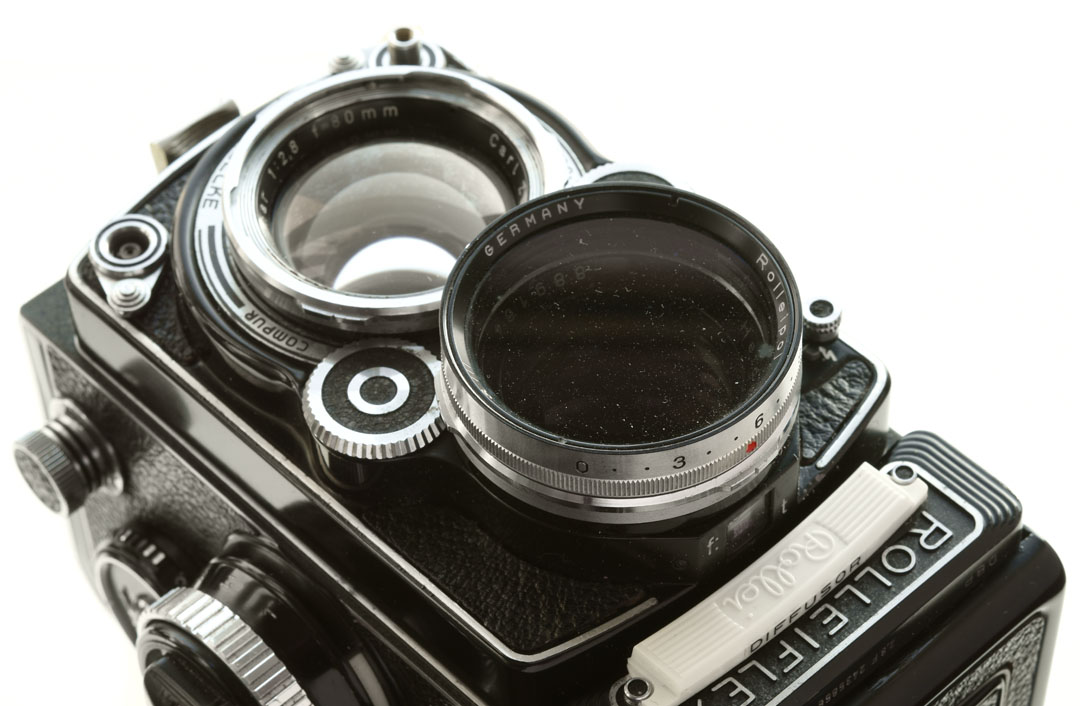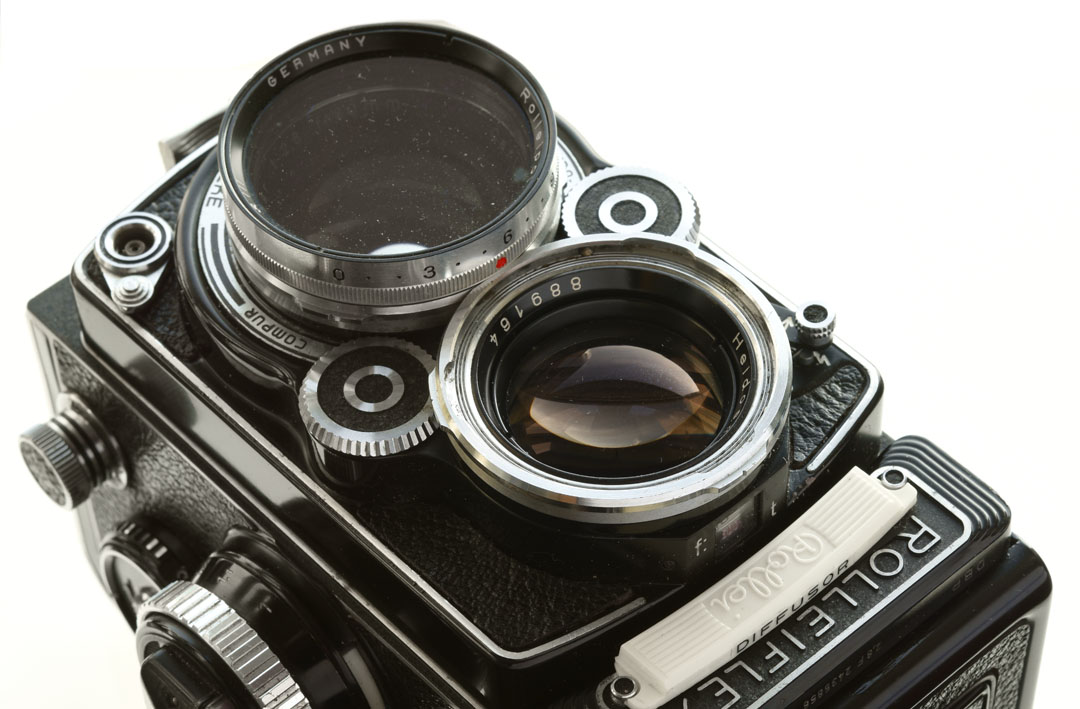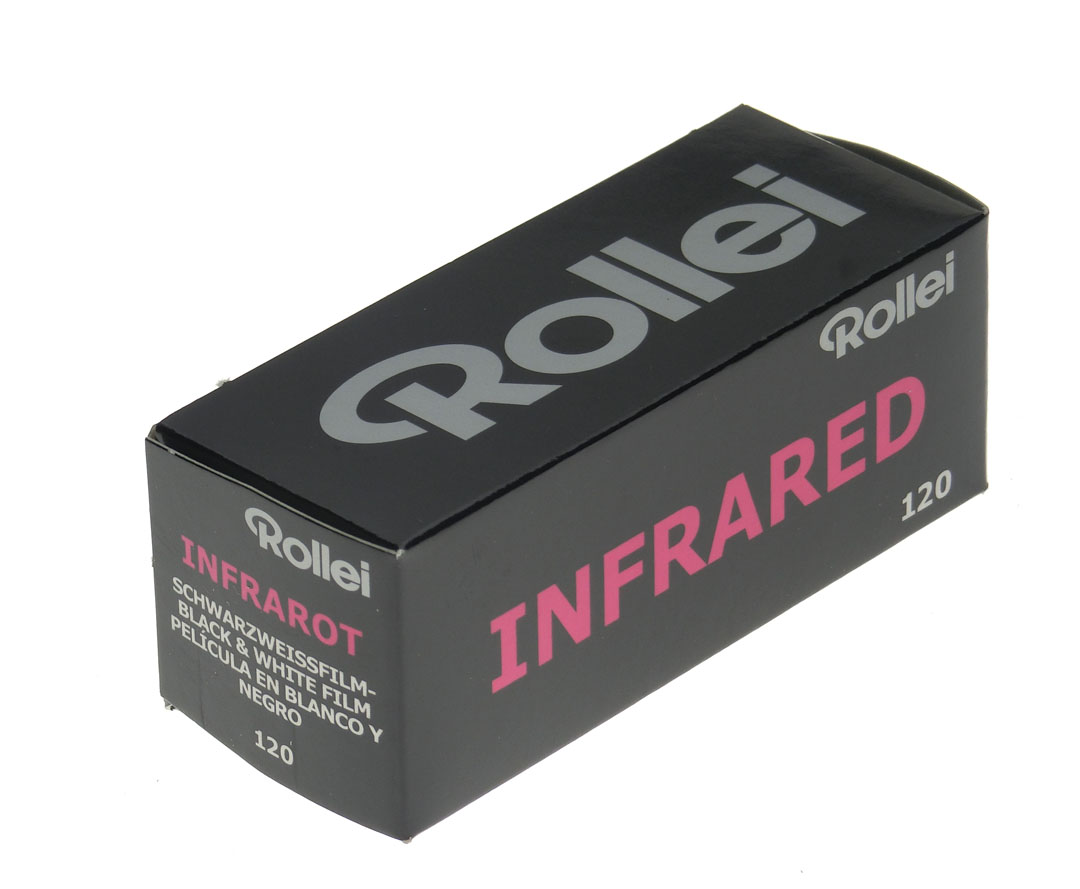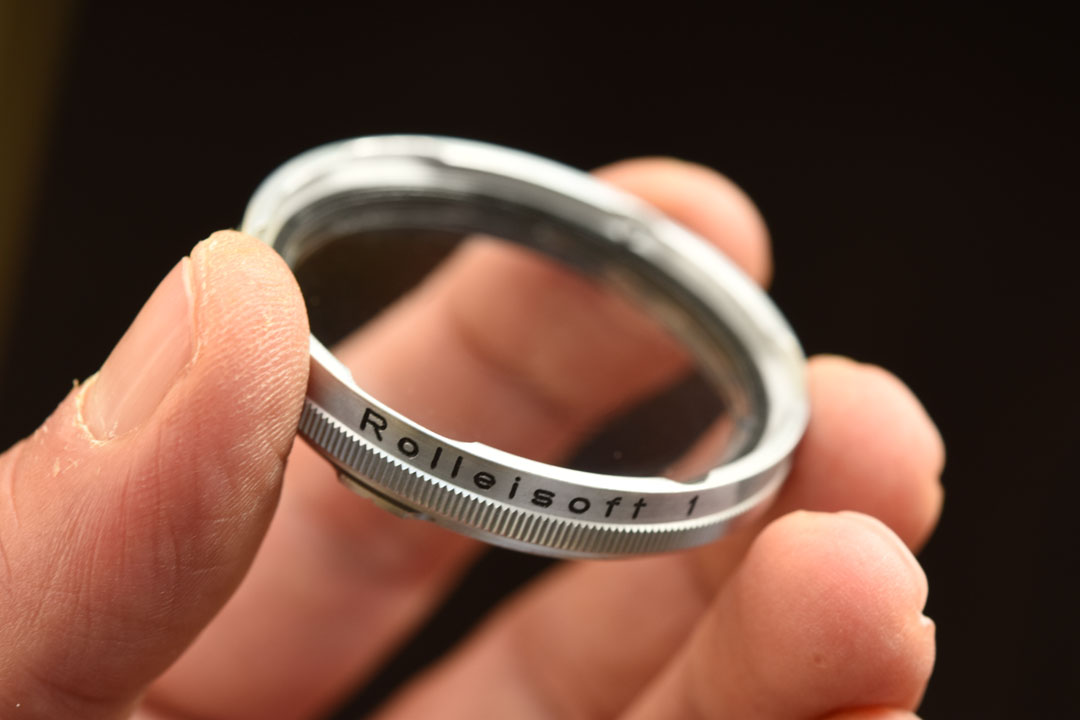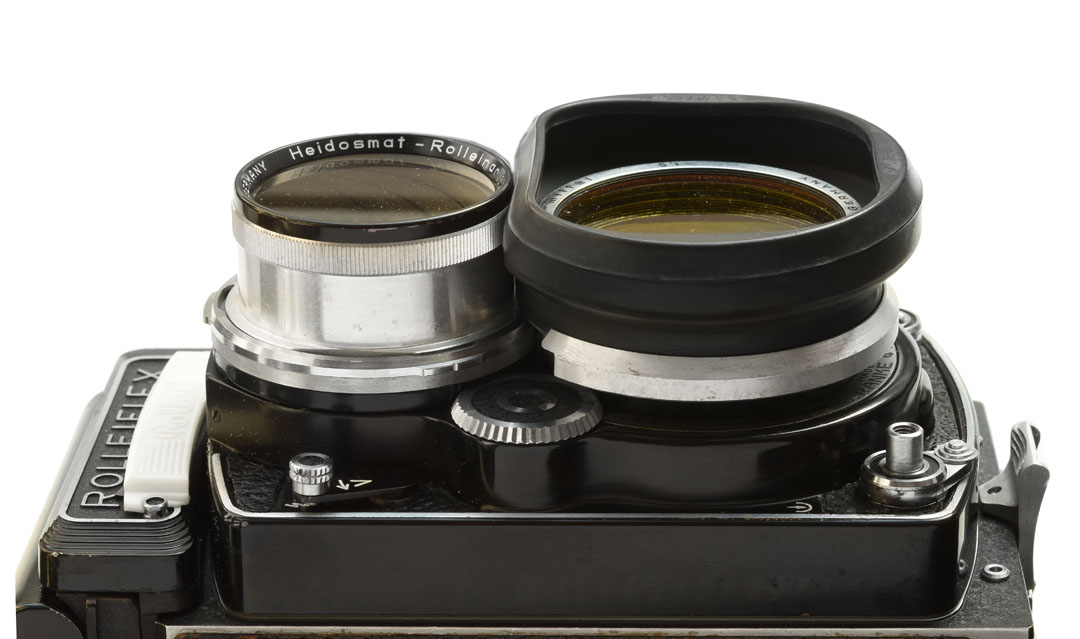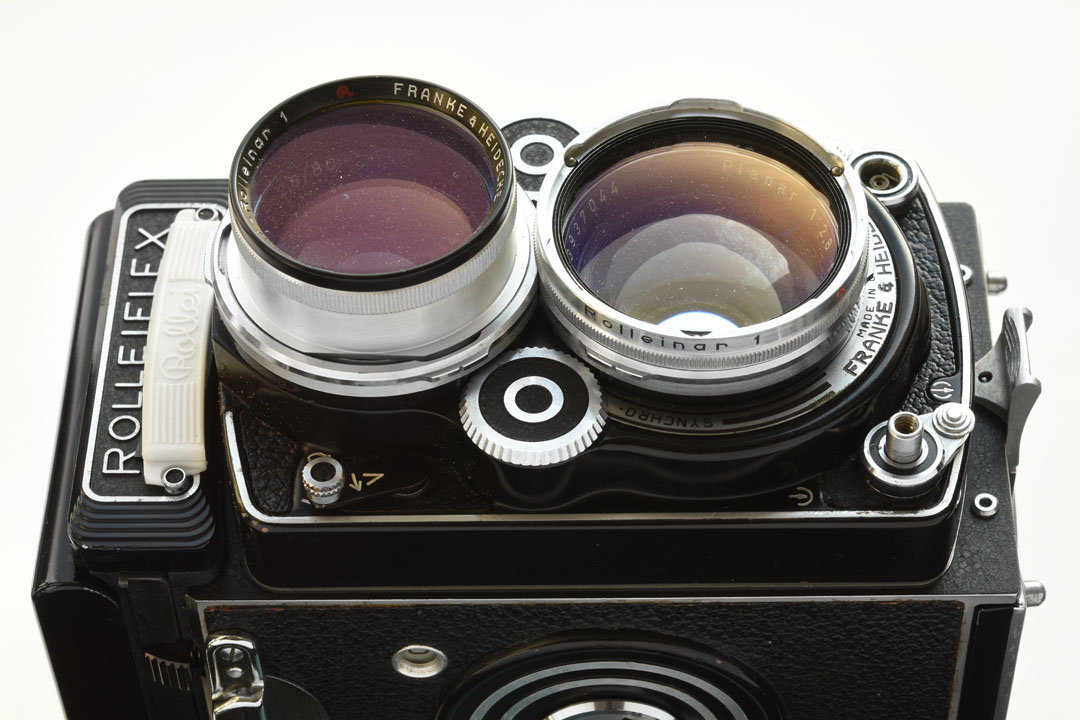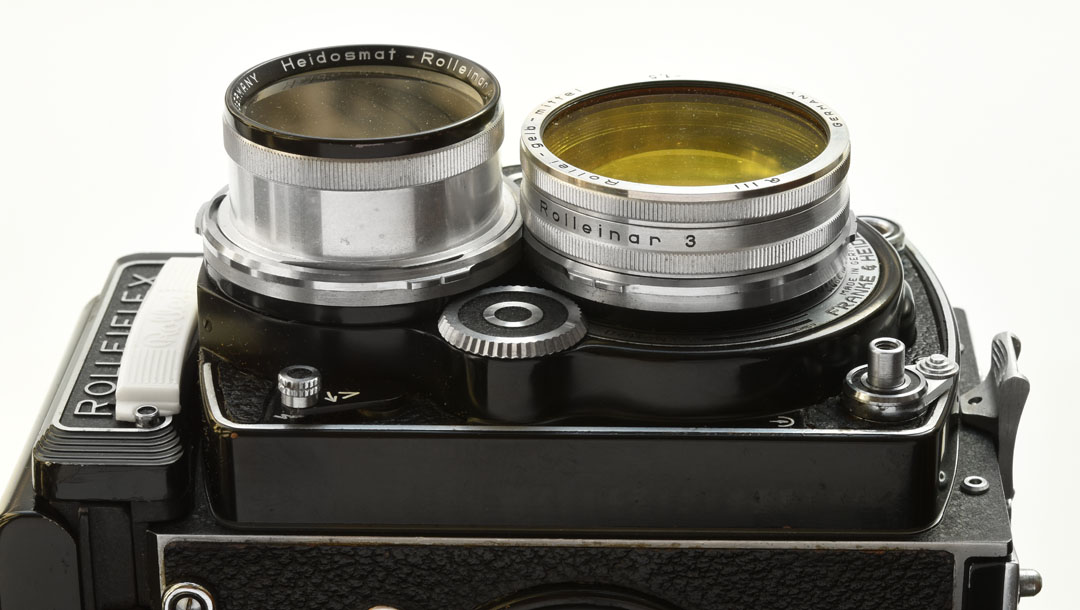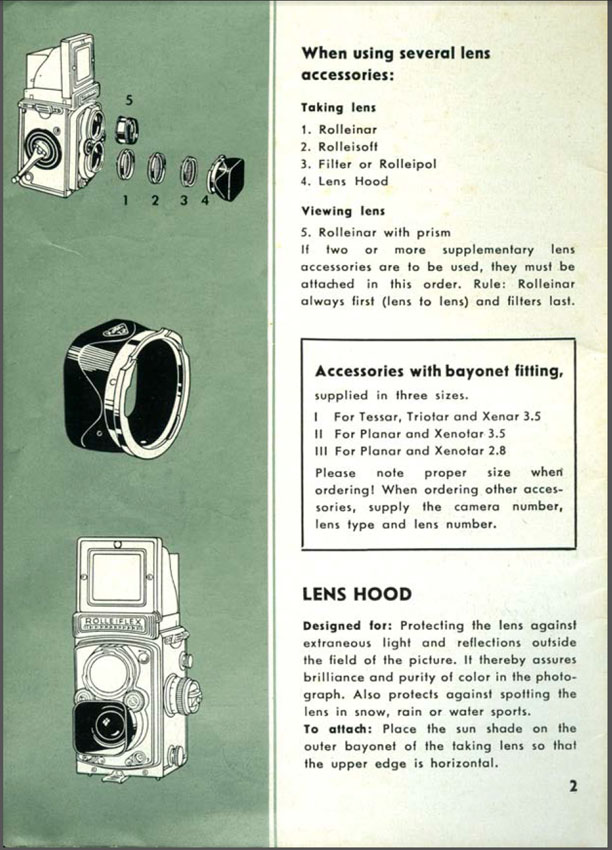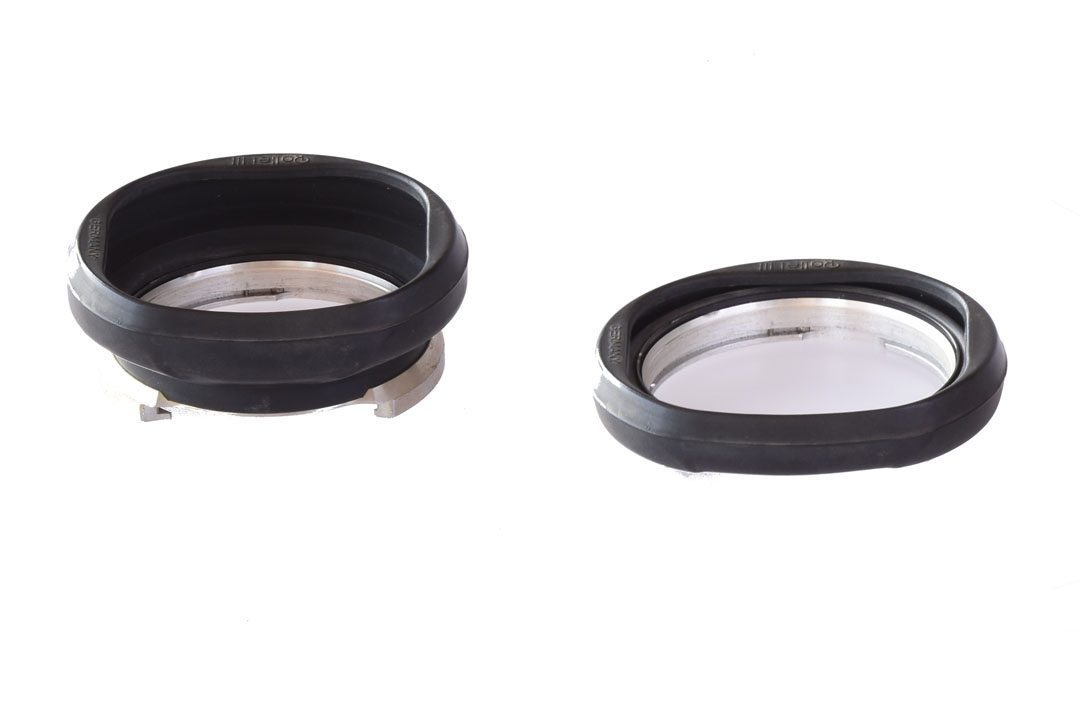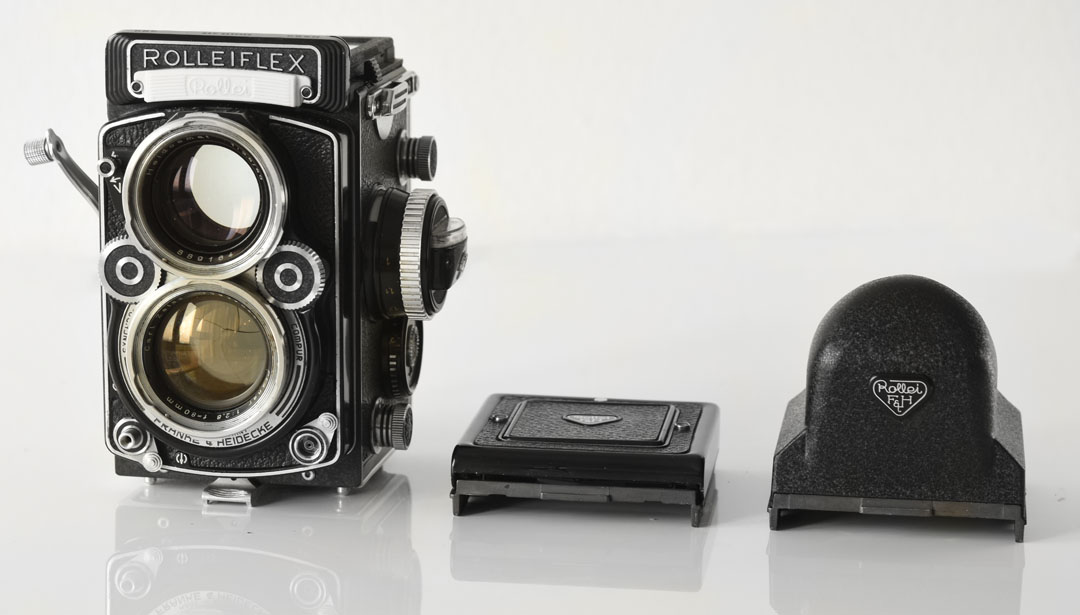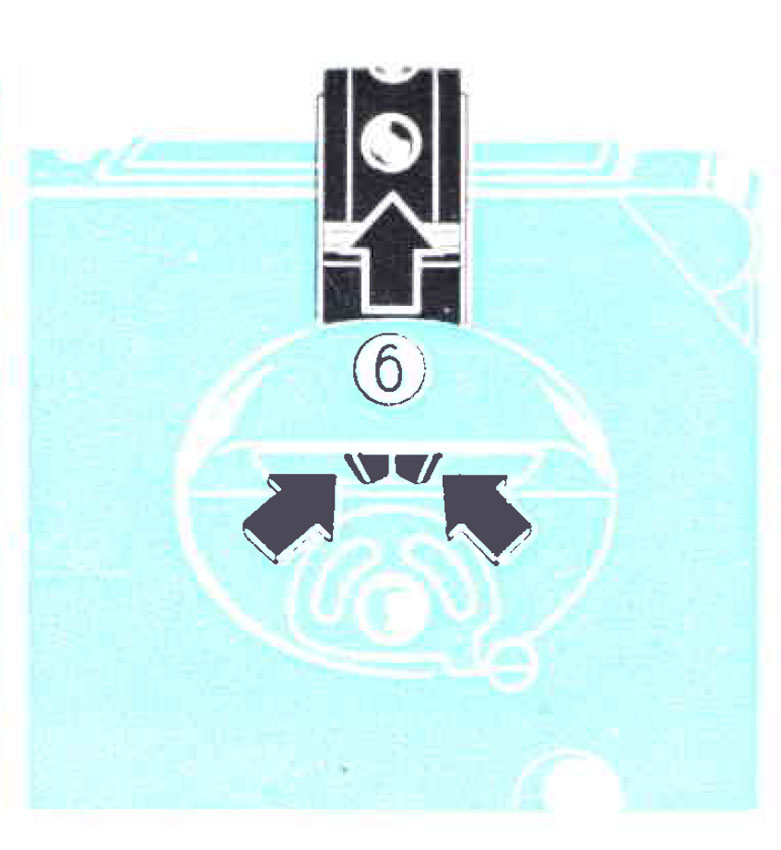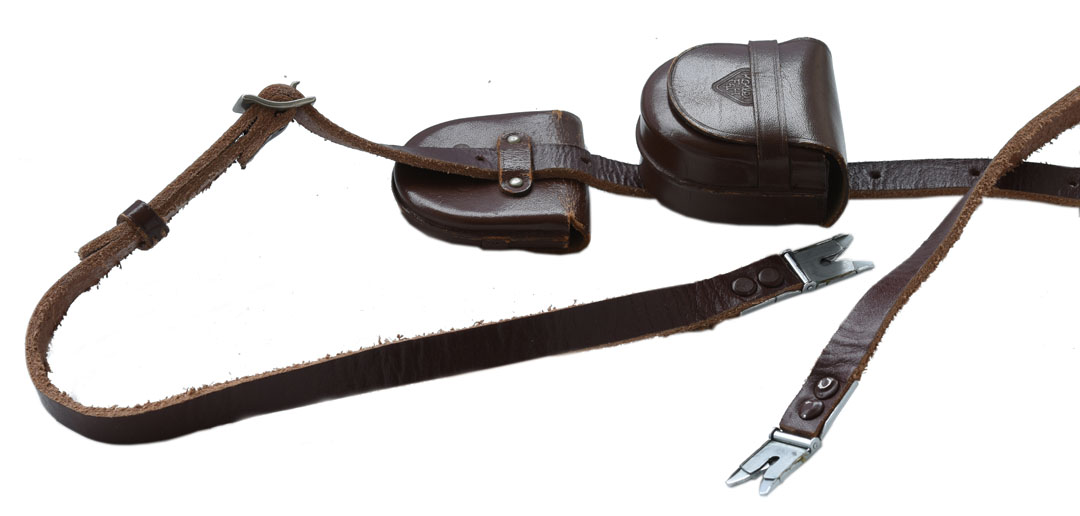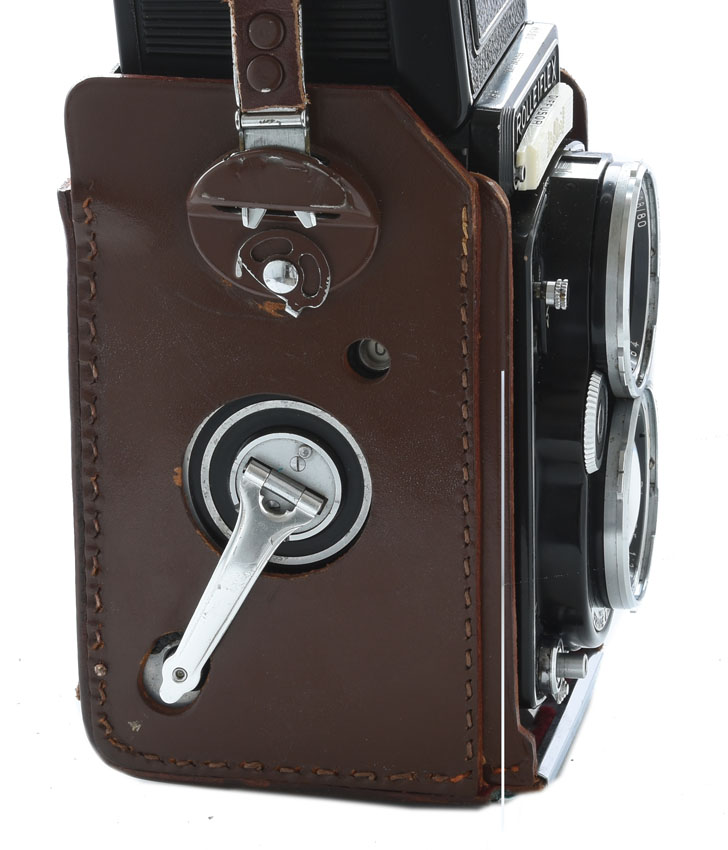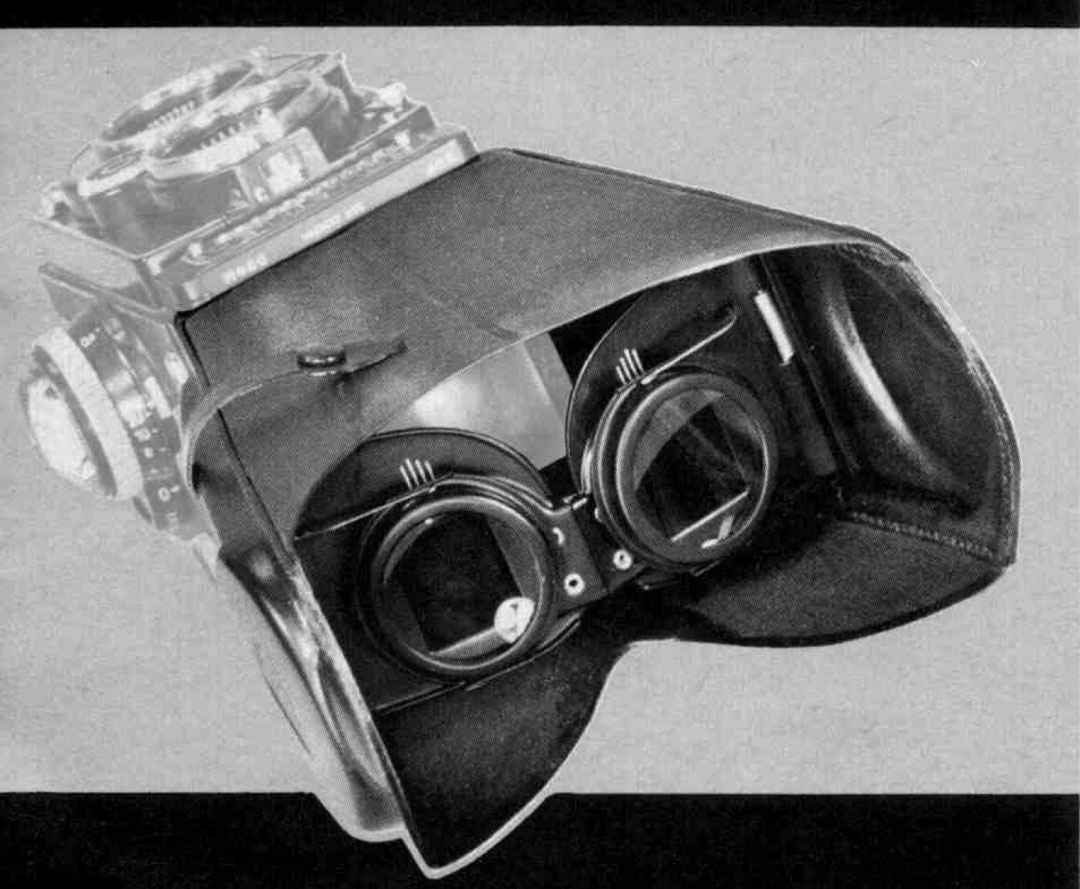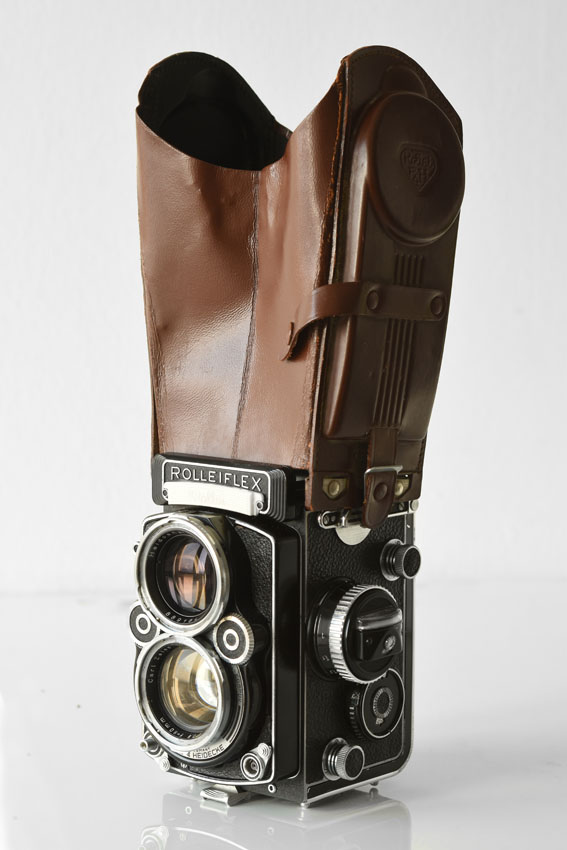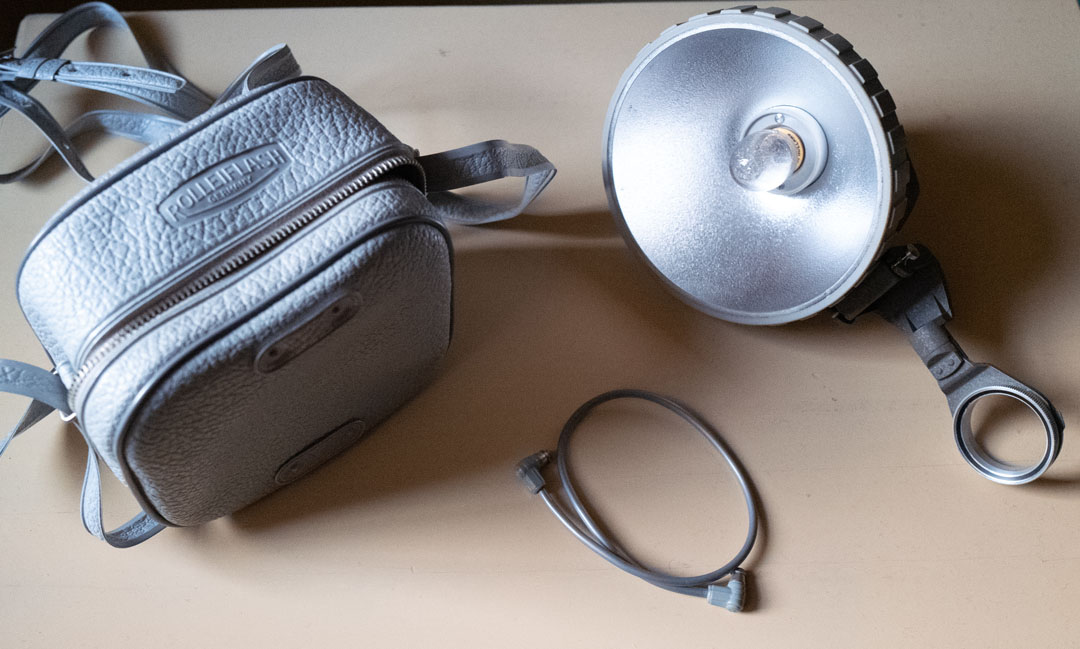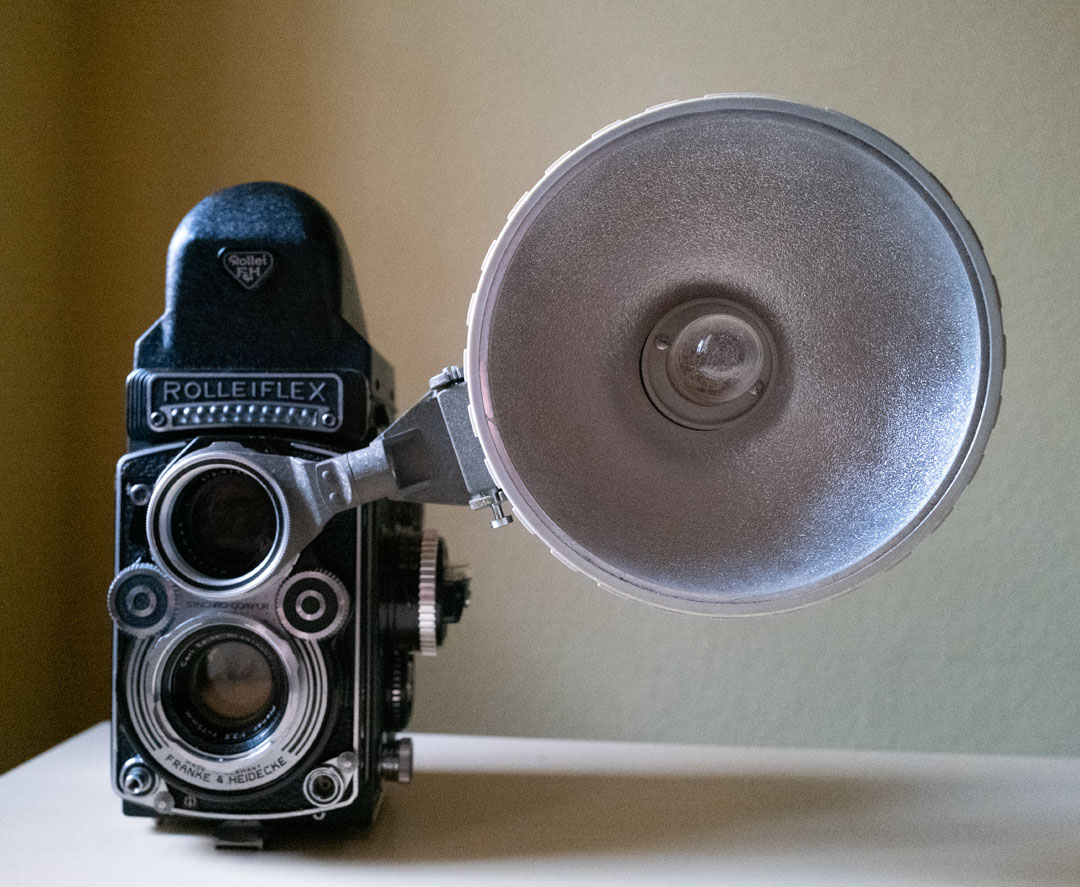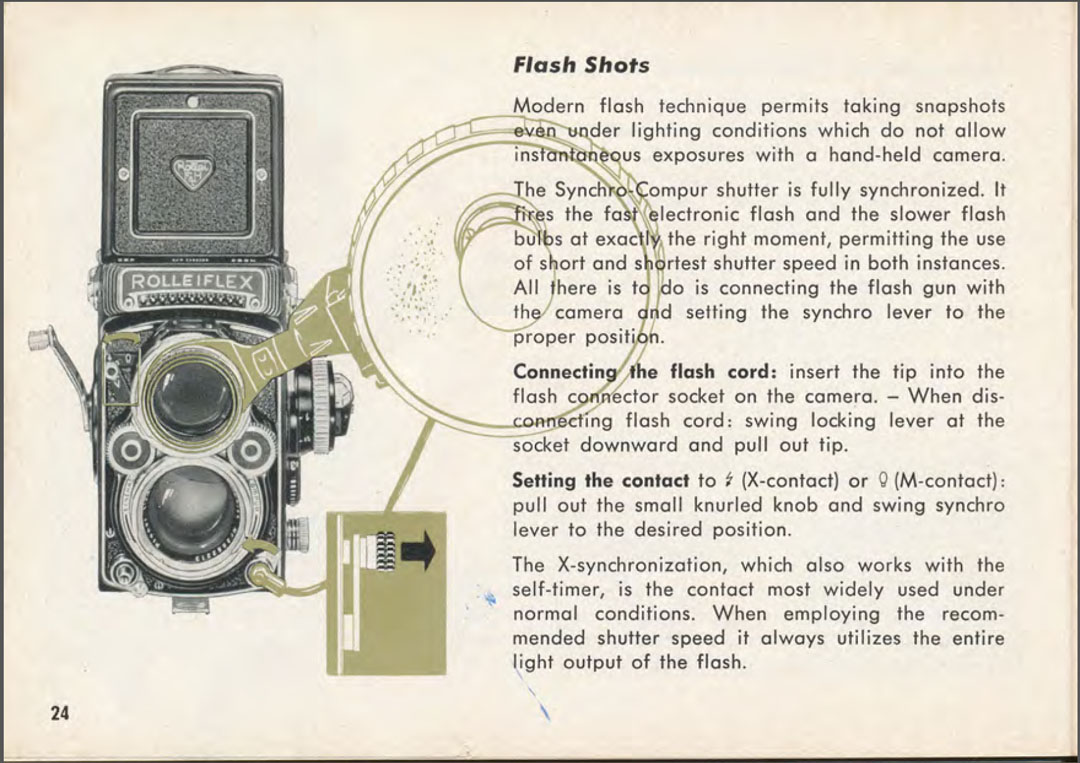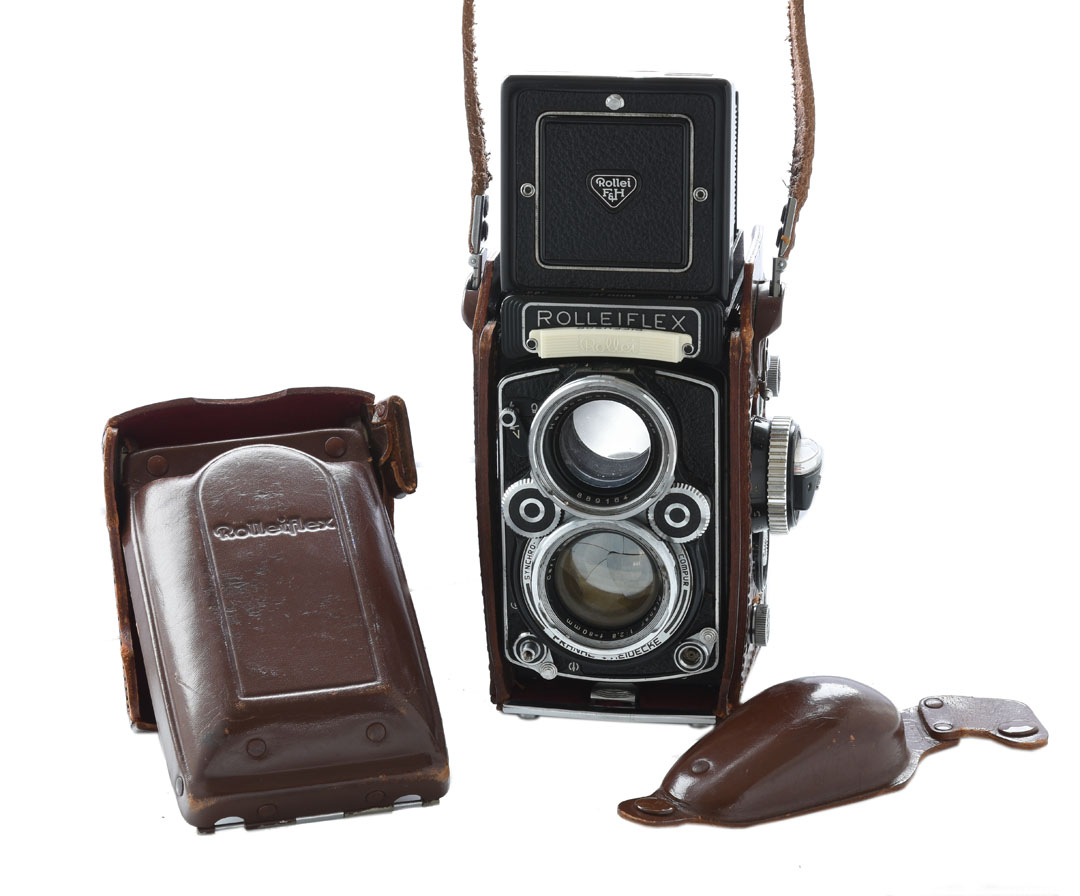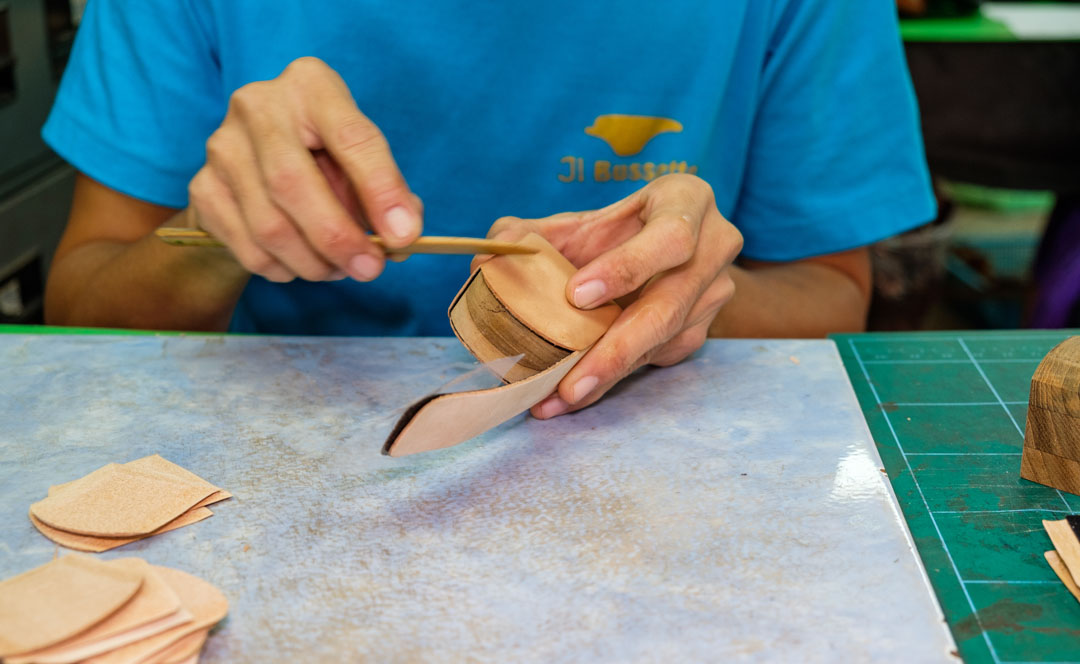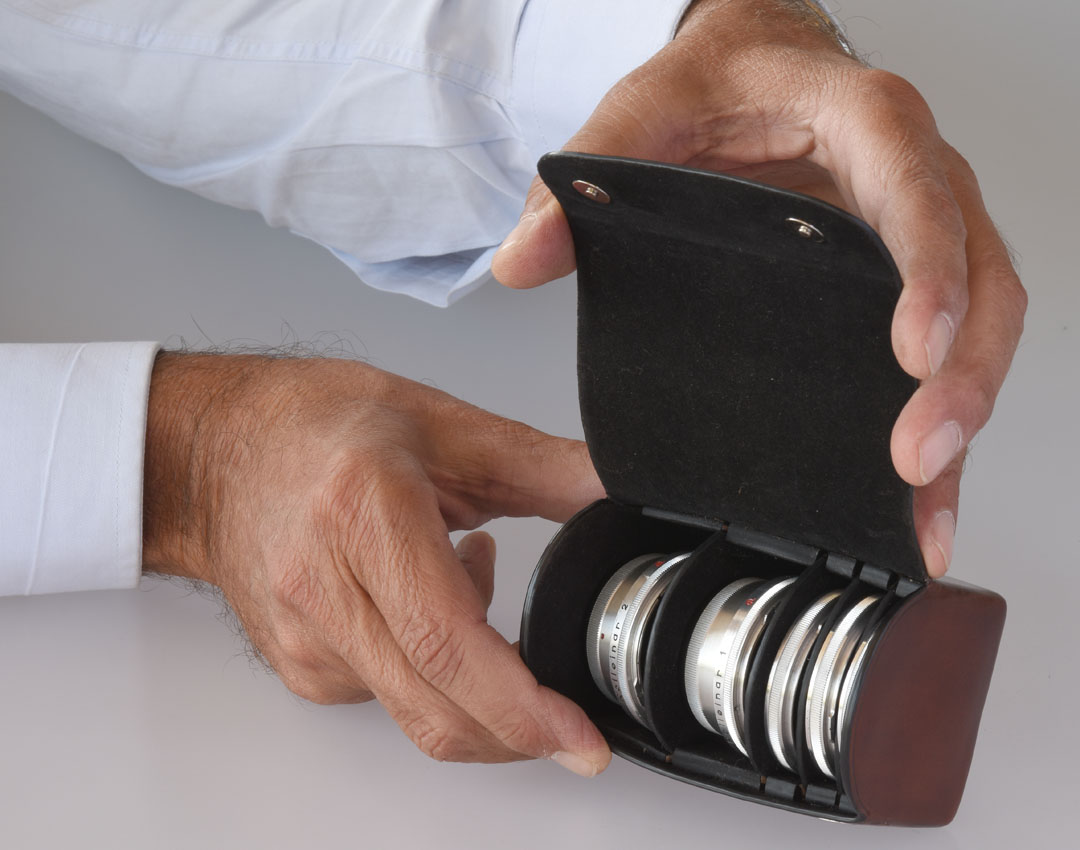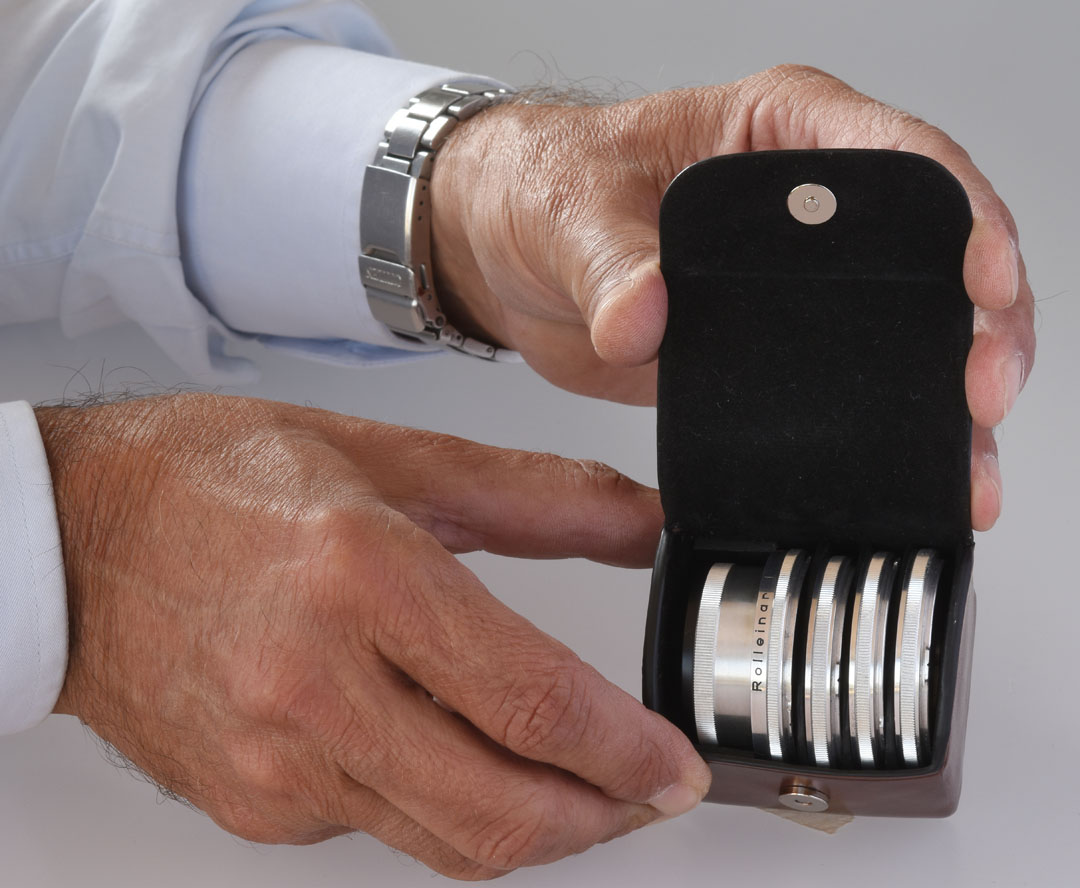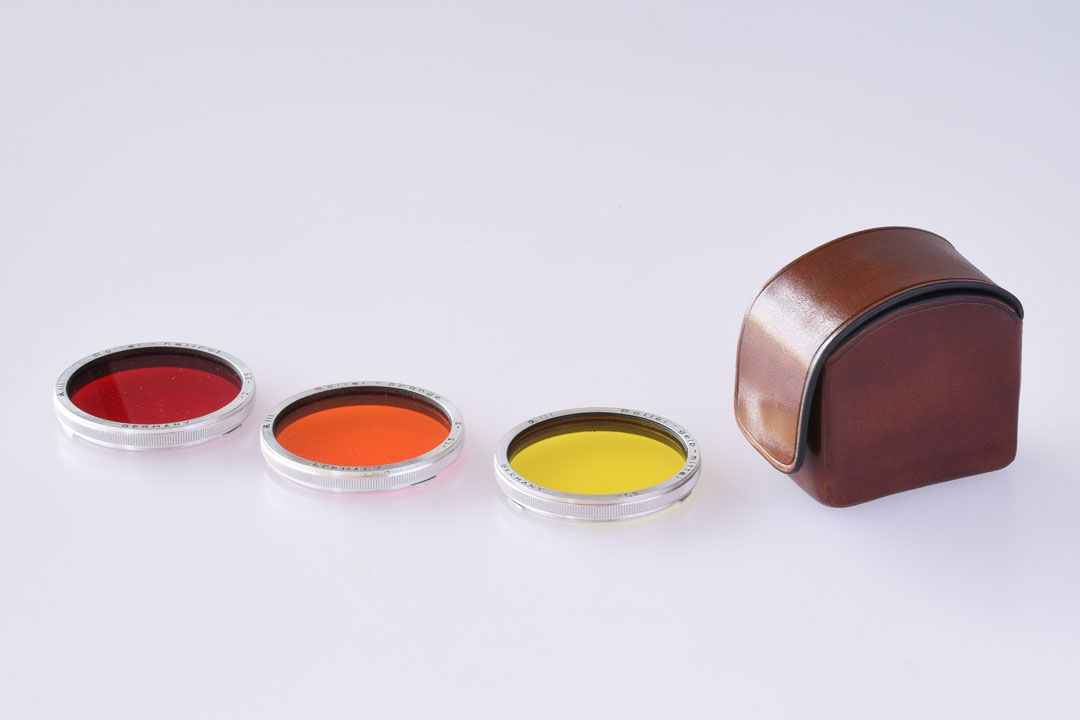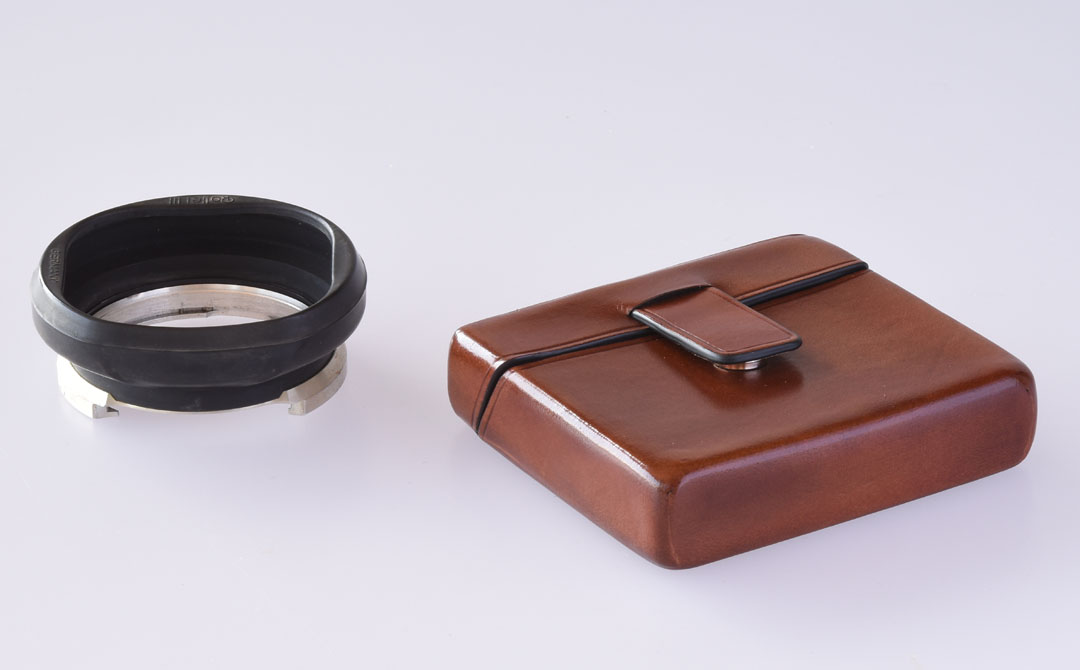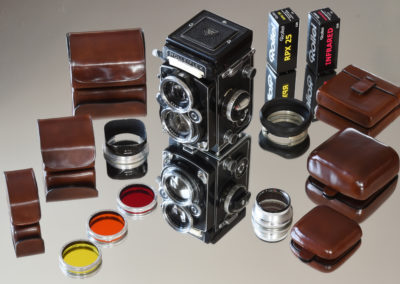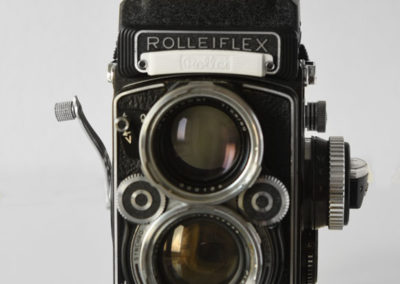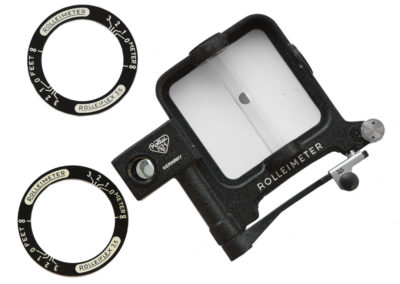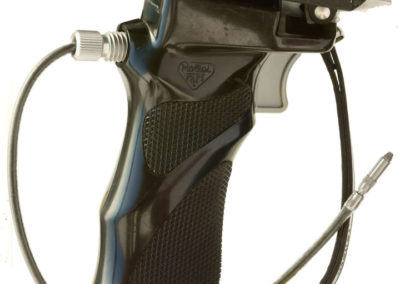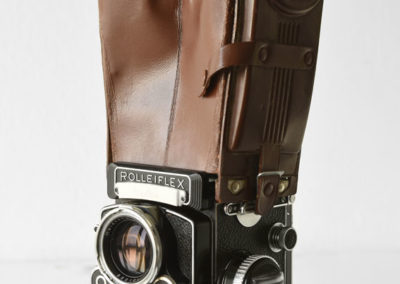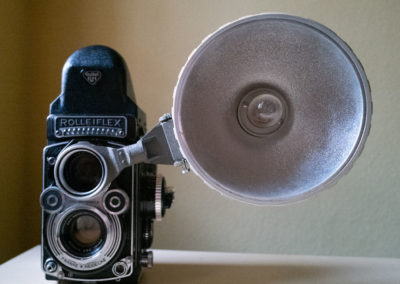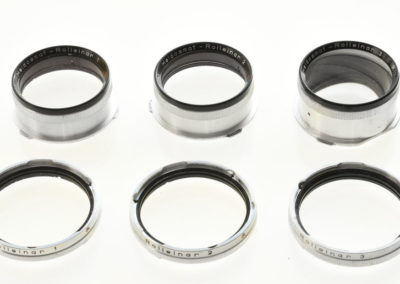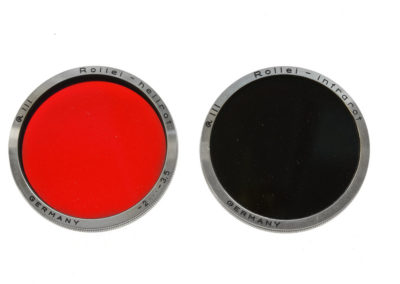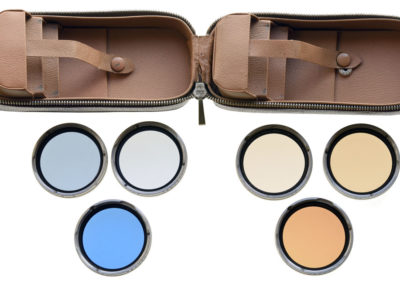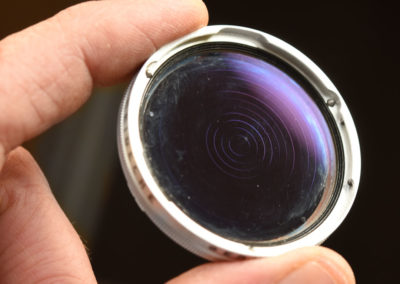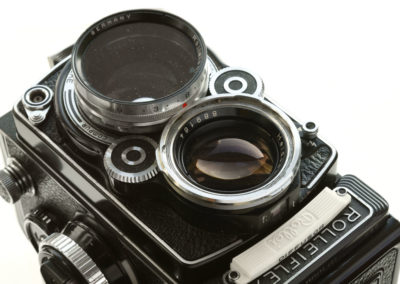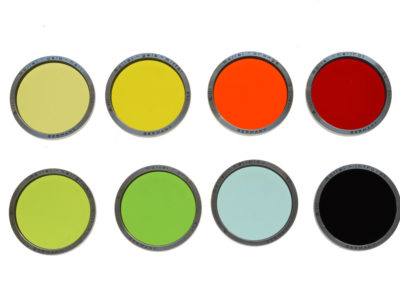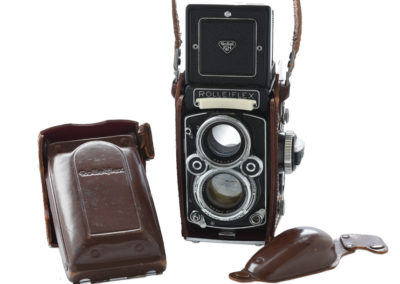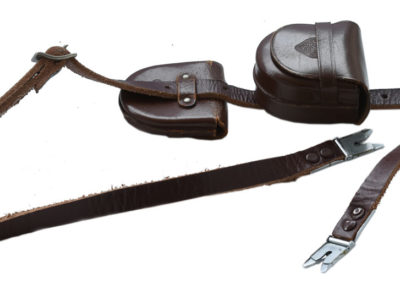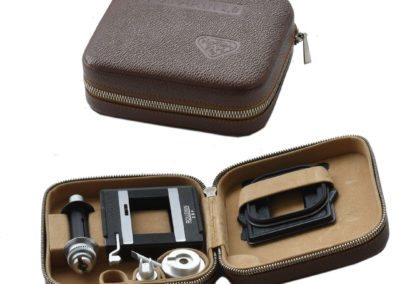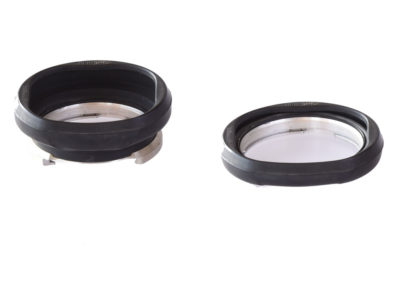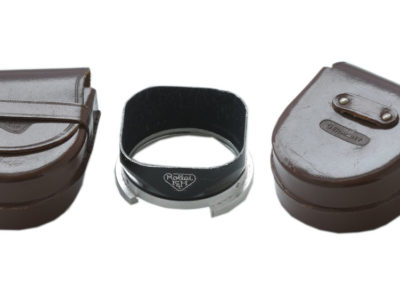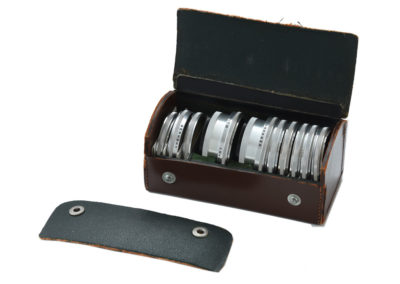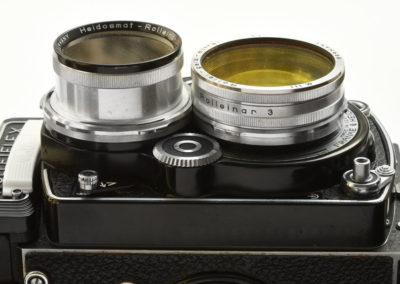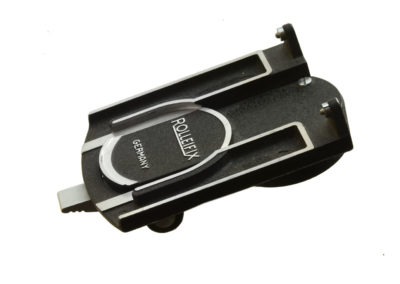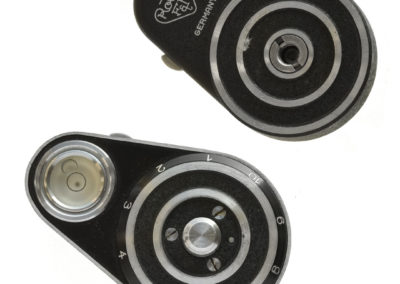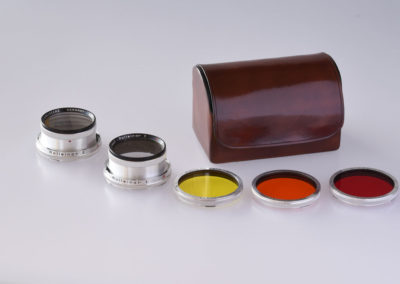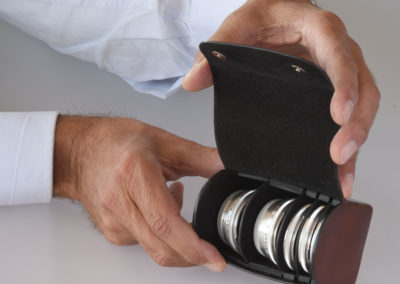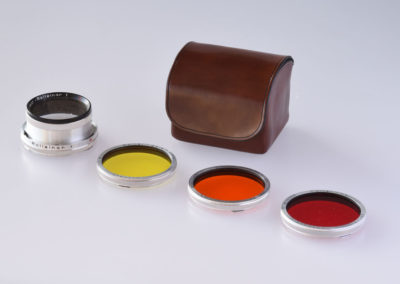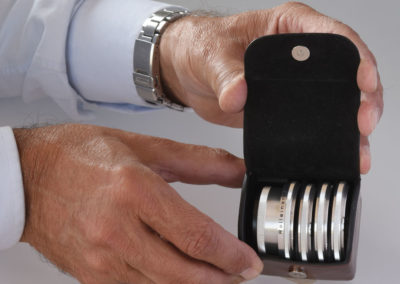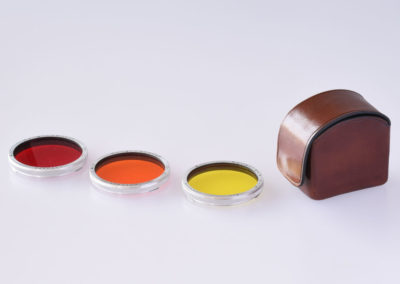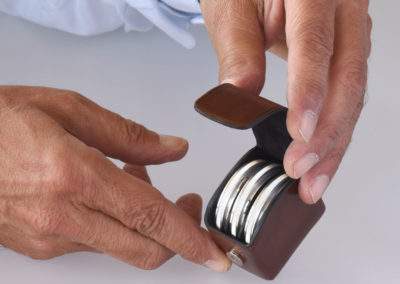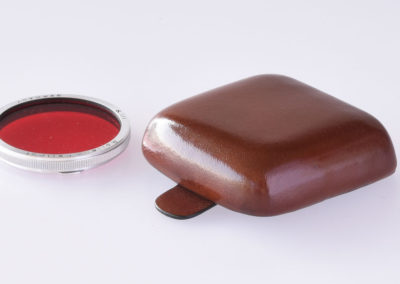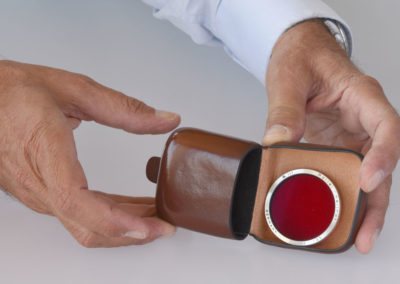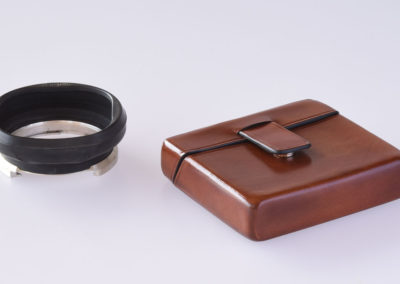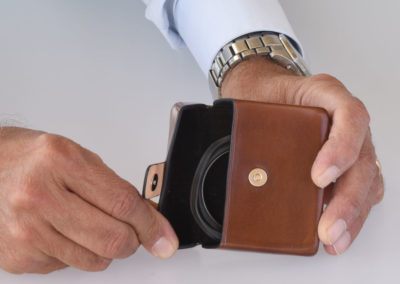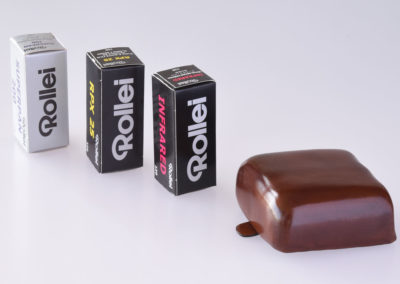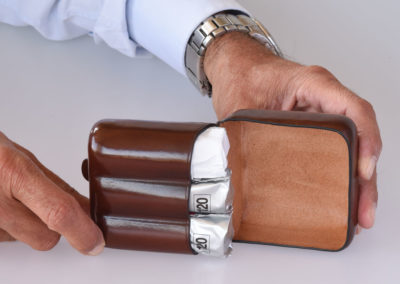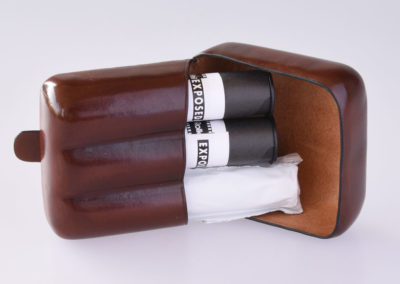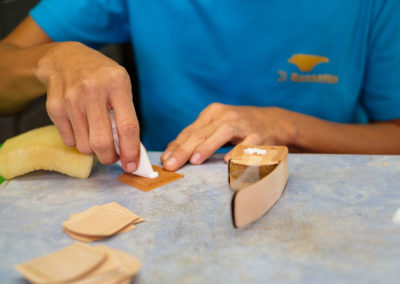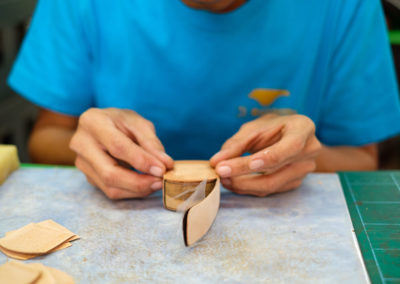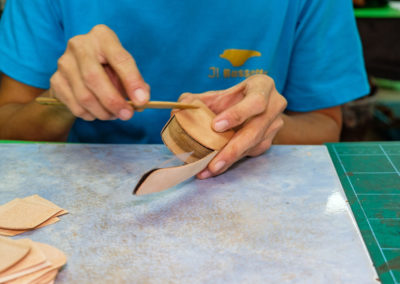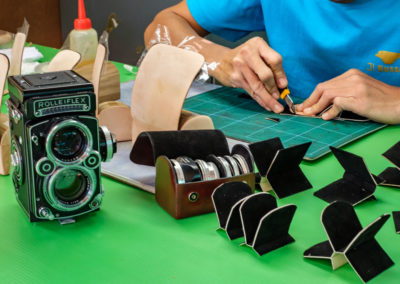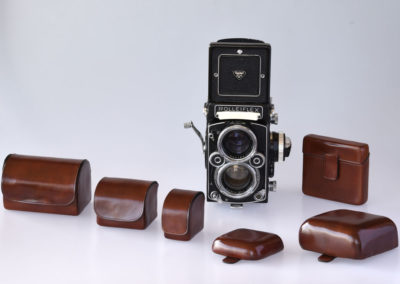Rolleiflex has been one of the most revolutionary cameras in Photography history, along with Leica, Nikon and Hasselblad, just to name a few.
Born of the idea of Franke & Heidecke, it was conceived in 1928 for the production of bi-optic medium size cameras.
Extremely solid, almost spartan – lenses have never been interchangeable – Rolleiflex is currently one of the most valued cameras among those who dedicate themselves to film photography, especially in black and white.
Rolleiflex is also well-known for a considerable and articulate series of accessories, such as filters, close-up lenses, hoods, flash, tripod sockets and panorama heads, just to mention a few.
Both cameras and accessories were produced with proverbial care, as well as all types of cases that were provided along with the accessories, in order to store and carry them.
On second-hand market, it is still possible nowadays to find both cameras and accessories, but the cases or, more often, the cases that have been used for decades, are not always in good conditions, since they are mostly stitched leather products: sometimes the cases become unsewn and difficult to repair or they are very worn; sometimes the accessory is available, a lens for example, but without its original case.
You can find below some of the essential Rolleiflex accessories and their original cases.
Let’s start with hoods, both the rigid metal and the collapsible rubber ones: they keep front lens away from flare rays, which reduce the quality of images, and at the same time hoods protect the front lens from impacts and from photographer’s fingers; a hood is essential either if you shoot on colour or black and white film or if you shoot with a digital camera, even though digital has nothing to do with Rolleiflex.
Then let’s talk about filters: Rolleiflex produced protection filters for the front lens, again essential for those who shoot both in colour and in black and white; polarizing filters, useful in both cases; conversion and compensating filters, for colour photography; soft focus filters, to soften faces in portraits; yellow, orange and green filters for black and white photography.
All these filters are essential to obtain perfect negatives and, consequently, perfect prints.
Since the camera doesn’t have interchangeable lenses, Rolleiflex produced additional lenses with three different dioptric adjustment levels in order to shoot at close range, made up of a filter and a second part that, together with the vision lens, allows the framing of the scene or of the exact detail that will be then exposed on film. This other component is called Rolleinar: very desired, it is available, as well as the above-mentioned filters, for Rolleiflex Group III, II and I.
As said above, Rolleiflex produced also fast sockets, panorama heads, pistol grips and flash. Except for flash, which was sold in a soft plastic container, fast sockets and panorama heads didn’t come with cases.
This kind of accessories (filters, additional lenses), besides being very fragile, are small and need an adequate protection and a suitable case for carriage, in order not to lose them in the bottom of a bag or when falling out from the pocket of a jacket.
It is necessary to highlight that each of these items is essential to get perfect negatives and to obtain the best from your Rolleiflex, while taking full advantage of the quality of Zeiss lenses assembled on Rolleiflex.
As said, shooting in black and white without the suitable filters means that you take advantage of the potentiality of the film for less than 50%. It’s very difficult, sometimes impossible, to recover this lack during printing. Carrying these accessories around, allows to obtain exceptional shots and improves considerably the quality of both black and white and coloured prints.
Koece accessory holds two Rolleinar additional lenses, one rigid hood and five filters. The style featured below is very worn and its flap is irremediably broken.
CESIX: this is one of the most beautiful Rolleiflex cases; it holds 6 colour compensating filters, stored in two slots, one for light blue compensating filters (tungsten-daylight) and the other for the amber one (daylight-tungsten).
This disposition has been realized so that, even in case the items fell on cement, they would emerge unscathed (without tumbling out from the case).
Rolleiflex used to produce 8 filters (both colour compensating and conversion filters), they could be purchased separately or along with CESIX case (in this instance, the filters provided were 6).
Below, you can find the case suitable for a single filter. The case were sold separately from the filter, proposed in its circular Plexiglas pack along with a carton box.
Below, two original Rolleiflex tables to be used as a guide for black and white filters; also absorption levels of each filter are stated in EV.
The main Rolleiflex black and white filters. These filters are quite hard to find and they go from the light yellow one to the Infrarot. The best one, used to darken clear, cloudless skies, is the Orange; in order not to lose brightness you can use the medium-yellow filter, even if this provides a less dramatic result.
Two different types of UV filters and an example of Rolleisoft and Rolleipol filters. The UV filter doesn’t have a big impact, especially on black and white photography, but it is a valid filter to protect front lens.
Rolleipol filter has a graduated scale and a red land mark. It has to be assembled on the vision lens and rotated, while sighting the waist level finder, until you can find the correct polarization, then you need to assemble it on the camera lens without rotating it, so that the land mark is positioned on the top of the camera lens, as for the assembly on the vision lens; at this point it is possible to shoot.
The Infrarot is a unique filter: it absorbs all the radiation of the visible and allows the passage of the wavelength from 750 to 1000nm. It is used with infrared films. It is quite rare and currently it can be used with the few infrared emulsions available on the market like, for example, the Rollei Infrared 400. In the images here displayed it is possible to see that it appears completely black if put between the camera and a visible image while, if it is put between the camera and the Sun, it allows the vision of the infrared radiation emitted by the Sun. Here, it is compared with the Red Rolleiflex filter 25A that cuts the part of radiation of the visible and that can be used with hyper panchromatic films, like the Rollei Retro 400S
Rolleisoft filter is available in two different intensities, Rolleiflex 0 and Rolleiflex 1. It is useful especially for portraits: it softens the image without losing definition; when the contrast between very bright and dark areas is high, it can produce a pleasing halo effect. It can be assembled with another filter: it has a double bayonet, an upper one to be put on the camera lens and a lower one to be matched with another filter. Differently from other diffuser filters, which have a chemically etched surface that creates a gradual sensation of scattered hazing of the image, to the detriment of sharpness, Rolleiflex Softfocus have a series of concentric circles on the external surface of the filter, capable of softening the image without removing sharpness; for a more marked effect they can be assembled together, the final result can be modulated by keeping the diaphragm completely open to obtain the maximum softness and decrease it by gradually closing the diaphragm.
Filters came with a Plexiglas case: the pouch was optional; while additional lenses were sold along with their standard pouch.
Rolleinar additional lenses are available in three different dioptres: 1, 2 and 3. As the dioptres grow, the enlargement power increases. Every Rolleinar Group is composed by a lens to be put on the camera lens that allows to see the framed area and the enlargement directly, while correcting the parallax; the other lens needs to be positioned on the camera lens. Even if they are “simply” additional lenses, the quality of the photo is excellent.
Rolleinar lenses, besides being designed to be used serially, can be also matched with one of the many Rolleiflex filters, both for black and white photography and for colour photography. At the same time, you can also use a hood, to be positioned on the base of the camera lens with the usual bayonet fitting.
Rigid hood with its case and collapsible rubber hood. The first one is also a valid protection for the frontal lens, the collapsible one can be left on the camera lens and closed when unused, in order to close the camera leather case properly.
Tripod quick connector: it allows to both firmly fasten your Rolleiflex on the top of the tripod and unfasten it quickly. It is always a best practice, when you work with a tripod and you need to move over between one shot and the next, to unfasten the camera from the top of the tripod in order not to keep it in critical conditions during the transport of the tripod, especially if the legs are completely open and run the risk of getting caught on.
Panorama head. It comes with a bubble level and it is used to shoot the sequence of images that, once printed, allows to obtain panoramic pictures with different angles of view, depending on the number of pictures taken, up to an angle of view of 360 degrees.
The style featured in the illustration is older than that featured in the picture.
Pistol grip. It has a leather strap with a fast socket and a remote control, it is possible to hold the Rolleiflex firmly and activate the shot by pulling the trigger on the side of the gun.
Rolleiflex pentaprism: a jewel of optics that straightens the edges of the image for an actual vision and enlarge the image displayed on the focusing screen: it quickly replaces the waist level finder provided. Its pouch is beautiful too, made of a very rigid leather and with such internal dimensions that the pentaprism doesn’t touch the case, so that it is further protected from potential impacts.
Rolleikin: it is a kit designed to allow the use of 35mm film into Rolleiflex cameras; the assembly is reversible and quite complex, it was used especially by professionals who wanted to use Rolleiflex to make passport photo, while saving film.
Rolleimeter, certainly one of the most sophisticated and complex Rolleiflex accessories; it allows, while sighting the waist level finder set as sports finder, to focus through a telemetry system, with an extreme focus precision. The assembly is not as complex as that of Rolleikin but undoubtedly intricate.
The original Rolleiflex strap comes with two dovetail joints that allow to quickly assemble the strap either on the bag or on the camera and then unfasten them as quickly. Considering the weight of a Rolleiflex and the extreme simplicity with which it is possible to unfasten the strap, it seems strange that it doesn’t accidentally unhook itself, but actually it never happens; this is maybe the most quick and smart hooking system in Photography history. Most of the cases designed by Rolleiflex had on their back side a belt loop to keep them securely fastened to the strap. Cross body camera, cross body accessories, no bags!
Rolleiflex Extension Hood: this is one of the most original and probably the less sold item in Rolleiflex history. It is a kind of huge collapsible leather hood that can be inserted in the place of the waist level finder to have an adequate view of the focusing screen without the problem of the light that may hit the photographer’s eye during focusing; there are 2 collapsible lenses inside, with enlargement power of 2x, to have a clear and binocular view of the focusing screen. Personally, they call to my mind those gunnysacks with a handful of hay that hung on the face of the horses hobbled to carriages. And the image of whom uses it is not much different…
Rolleiflash: this is one of the most recent items, it works with one-shot lamps. Its peculiarity is the fact that it can be put directly on the vision lens by using the bayonet for the filter joint. Strangely, the case is made of plastic.
The Rolleiflex bag is a real masterpiece of saddlery and leather industry. To pull out the camera you almost have to “twist” the case. It has a portable lateral protection in leather to defend the focusing ring.
The front of the bag can be removed. While inserting the case, you have to make the control level pass through the specific hole, so that it can be used also when the camera is into the case.
When the camera is in its bag, the transport lever is positioned on the outside of the pouch that carries the film and the shutter release button, at the same time, it is also possible to read the frame counter: a perfect case.
Many collectors of Rolleiflex cameras and accessories own the original Rolleiflex cases, that sometimes are in very good conditions and some other time are very worn or partly unsewn. But Il Bussetto, besides proposing cases similar to those originally designed, offers also some unreleased cases, in which it is possible to store your own set of accessories, choosing what is necessary for the shooting that you are going to realize.
Photography means also method, tidiness and cleanliness. The cases are the perfect way to always bring with you the suitable accessories for shooting, perfectly stored and protected from grease and dirt.
An Italian leather manufacturer, Il Bussetto, found a way to solve the problem of the lack of cases for Rolleiflex accessories by creating and producing a new dedicated line. There are 6 cases currently available, but the range will be expanded in the next few months for sure.
The cases are designed to carry the accessories both of Group III and of Group II, that define two categories of Rolleiflex cameras, the former with a lens socket with a larger diameter than the one of the latter. Il Bussetto cases have an innovative closure compared to that of the original ones: they come with magnetic buttons that allow an easier opening and closure than the original ones, which had a buckle closure, a zipper or snap buttons. The leather is Italian and it is vegetable tanned and hand painted following an ancient technique. The manufacturing is completely artisanal and many of the cases proposed are made on wooden moulds, on which the leather is softened with the help of steam and hot water and gradually takes the shape of the mould. Most of the cases are completely seamless and this ensure durability over time.
The external diameter of Rolleiflex Group III filters is 46mm, so the cases designed by Il Bussetto are suitable also for other filters such as, for example, those for Leica, provided that they have the same diameter.
An example of Leica E 39 filters: they have a smaller diameter than Group III and Group II filters, so many of Il Bussetto cases are suitable for the majority of Leica filters.
Based on the big range offered by Rolleiflex, Il Bussetto developed, up to now, 5 cases and an additional one to carry films, either for those wrapped in their seal package or especially for the unpackaged ones.
23-001: Big case: maybe one of the smartest items, because not even Rolleiflex produced it with this kind of compartments. The original case was sold separately from the accessories, because it was made to carry various accessories. This case is suitable for either 3 filters + 2 Rolleinar lenses, or for 3 filters + 1 rigid hood + 1 Rolleinar lens. All the accessories are carefully stored separately. This is the set of accessories that all Rolleiflex owners should always bring with them. The internal part is finished in soft black velvet, to protect the outer edges both of filters and of additional lenses. The case is fit both for additional lenses and hoods of Group III and Group II.
23-002: Case for 3 filters and 1 additional Rolleinar lens: Medium case, suitable for 3 filters, carefully stored separately, and for 1 Rolleinar lens or 1 rigid hood; more compact than the previous style, it doesn’t allow the storage of 2 additional lenses, so it is necessary to choose between the additional lens and the rigid hood. This is solvable by keeping the hood assembled on the camera lens. Suitable both for Group III and for Group II accessories.
23-003: Case for 3 filters: very practical and pocket-sized, it is suitable for 3 filters, carefully stored separately. It is fit both for Group III and for Group II accessories. It can be useful also for who wants to keep more than 3 filters at hand: you can carry also items 23-001 and 23-002 and add this case in order to always bring 6 filters with you. This case is suitable to carry also 3 filters with threated connection up to a specific diameter, so also a non-original Rolleiflex filter but, for example, a Leica or B+W one. Filters must have a diameter not larger than 46mm.
01-010: Squared filter case: inspired by the iconic coin pouch Tacco by Il Bussetto, this case holds 1 single filter both of Group III and of Group II. It can be matched with cases 23-001 and 23-002 to always keep another filter at hand, or it can be used singularly if you need to bring only one filter with you; differently from the cases previously described, here the closure is not magnetic but the item, once closed, opens up by pulling a flap. The case is fit for both with Group III and Group II filters. This case is suitable also to hold one filter with threaded connection up to a specific diameter, so also a non-original Rolleiflex filter but, for example, a Leica or B+W one. Filters must have a diameter not larger than 46mm.
03-006: Case for rubber hood: this case is designed to protect the Rolleiflex collapsible rubber hood and it is suitable both with Group III and with Group II. Again, it can be used singularly to carry only the hood or matched with item 01-010 to bring also a filter with you, or with item 23-003 to keep 3 filters at hand. Otherwise you can match it with the bigger cases, items 23-001 and 23-002, to carry 3 filters and one or two Rolleinar lenses in addition to the rubber hood. This case can hold also a remote control, provided that the cable is not longer than 20 cm. This case, as the previous one, can be used to hold a filter with threaded connection up to a specific diameter, so also a non-original Rolleiflex filter but, for example, a Leica or a B+W one. Filters must have a diameter not larger than 62mm.
04-026: Case for 3 Roll Films 120. This case is a new arrival, not only because it was not produced by Rolleiflex, but not even by any other medium-format cameras producer: it can store up to 3 roll films 120, either wrapped in their seal package– but without their carton box – or unpackaged and ready to be developed. It is very important that films 120, once exposed, are kept in the dark, so this accessory is essential, not only for the collectors of Rolleiflex cameras, but also for owners of any medium-format camera.
Conclusions.
Nowadays Il Bussetto – www.ilbussetto.it – proposes 5 cases suitable for Rolleiflex accessories (and for other camera accessories as well) and 1 suitable for 3 roll films 120. The selection of these cases is the result of an investigation that required months of work, prototypes and evaluations concerning dimensions. As previously said, other cases are going to be added to this first collection, also for accessories of other vintage cameras.
For the moment, the owners of a wonderful Rolleiflex can be extremely pleased.
Gerardo Bonomo
00 rollefilex
Le custodie in pelle de Il Bussetto progettate per gli accessori Rolleiflex più utilizzati
61 rollefilex rolleinar
Le tre lenti addizionali Rolleinar con relativo adattatore per il controllo della parallasse
58 rollefilex infrarot
A sinistra il filtro rosso, a destra il filtro Infrarot per la fotografia all’infrarosso
18 rollefilex cinghia
La cinghia in pelle utilizzata anche per avere sempre con sè i principali accessori
63 rollefilex rolleinar
La lente addizoonale Rolleinar 3 montata sull’ottica da presa insieme a un filtro giallo medio
00 rollefilex
Le custodie in pelle de Il Bussetto progettate per gli accessori Rolleiflex più utilizzati
